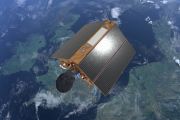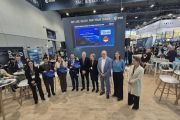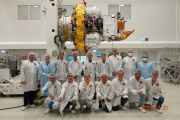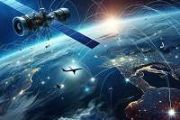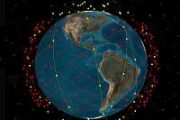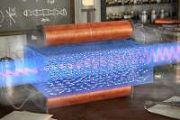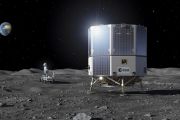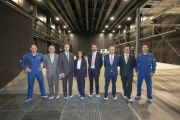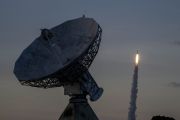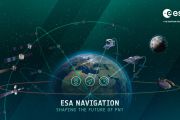
Copernical Team
Yokota AB aids Space Systems Command in historic US-Japan space partnership
 Yokota Air Base's very own 374th Mission Support Group and hosted Air Mobility Command unit, the 730th Air Mobility Squadron, assisted the U.S. Space Force Space Systems Command to deliver the first of two payloads to be hosted on Japan's Geo-based Quasi-Zenith Satellite System, Jan. 17.
The delivery marks a historic step in solidifying the U.S. government and government of Japan commitmen
Yokota Air Base's very own 374th Mission Support Group and hosted Air Mobility Command unit, the 730th Air Mobility Squadron, assisted the U.S. Space Force Space Systems Command to deliver the first of two payloads to be hosted on Japan's Geo-based Quasi-Zenith Satellite System, Jan. 17.
The delivery marks a historic step in solidifying the U.S. government and government of Japan commitmen Ivanhoe Mines and SES deploying low-latency satellite connectivity in Africa
 The Kamoa-Kakula Copper Project in The Democratic Republic of Congo will continue to enjoy high-speed satellite-based connectivity services as part of a new agreement between Ivanhoe Mines and SES, the two companies announced reported Monday.
The enhanced partnership builds on a successful five-year relationship between SES and Ivanhoe Mines and comes at a time of significant investment in
The Kamoa-Kakula Copper Project in The Democratic Republic of Congo will continue to enjoy high-speed satellite-based connectivity services as part of a new agreement between Ivanhoe Mines and SES, the two companies announced reported Monday.
The enhanced partnership builds on a successful five-year relationship between SES and Ivanhoe Mines and comes at a time of significant investment in Asteroid findings from specks of space dust could save the planet
 Curtin University-led research into the durability and age of an ancient asteroid made of rocky rubble and dust, revealed significant findings that could contribute to potentially saving the planet if one ever hurtled toward Earth.
The international team studied three tiny dust particles collected from the surface of ancient 500-metre-long rubble pile asteroid, Itokawa, returned to Earth b
Curtin University-led research into the durability and age of an ancient asteroid made of rocky rubble and dust, revealed significant findings that could contribute to potentially saving the planet if one ever hurtled toward Earth.
The international team studied three tiny dust particles collected from the surface of ancient 500-metre-long rubble pile asteroid, Itokawa, returned to Earth b A new model for dark matter
 Dark matter remains one of the greatest mysteries of modern physics. It is clear that it must exist, because without dark matter, for example, the motion of galaxies cannot be explained. But it has never been possible to detect dark matter in an experiment.
Currently, there are many proposals for new experiments: They aim to detect dark matter directly via its scattering from the constitue
Dark matter remains one of the greatest mysteries of modern physics. It is clear that it must exist, because without dark matter, for example, the motion of galaxies cannot be explained. But it has never been possible to detect dark matter in an experiment.
Currently, there are many proposals for new experiments: They aim to detect dark matter directly via its scattering from the constitue A paradigm shift in our understanding of a well-known astrophysical phenomenon
 Matter outflows in the form of jets are observed in astronomical systems at fast, medium and slow speeds. The fastest jets are highly relativistic, namely travel very close to the speed of light. The origin, as well as many properties of the jets, is uncertain. One of the puzzles, that jet velocities seem to have a bi-modal distribution - some very fast and others slow, with a gap in velocities
Matter outflows in the form of jets are observed in astronomical systems at fast, medium and slow speeds. The fastest jets are highly relativistic, namely travel very close to the speed of light. The origin, as well as many properties of the jets, is uncertain. One of the puzzles, that jet velocities seem to have a bi-modal distribution - some very fast and others slow, with a gap in velocities DARPA selects Aurora Flight Sciences for Phase 2 of Active Flow Control X-Plane
 DARPA has selected Aurora Flight Sciences to move into the detailed design phase of the Control of Revolutionary Aircraft with Novel Effectors (CRANE) program. This follows successful completion of the project's Phase 1 preliminary design, which resulted in an innovative testbed aircraft that used active flow control (AFC) to generate control forces in a wind tunnel test.
Phase 2 will focu
DARPA has selected Aurora Flight Sciences to move into the detailed design phase of the Control of Revolutionary Aircraft with Novel Effectors (CRANE) program. This follows successful completion of the project's Phase 1 preliminary design, which resulted in an innovative testbed aircraft that used active flow control (AFC) to generate control forces in a wind tunnel test.
Phase 2 will focu Liquid-mirror program to revolutionize telescope designs
 Today's glass-based ground and space telescopes are limited in their ability to provide resolved imagery of objects in geostationary orbit, 36,000 kilometers above earth. The cost to build and maintain complex optics large enough to effectively track items at that distance is prohibitive. Another key limitation of space-based telescopes is the escalating probability of in-orbit debris causing da
Today's glass-based ground and space telescopes are limited in their ability to provide resolved imagery of objects in geostationary orbit, 36,000 kilometers above earth. The cost to build and maintain complex optics large enough to effectively track items at that distance is prohibitive. Another key limitation of space-based telescopes is the escalating probability of in-orbit debris causing da Milky Way found to be more unique than previously thought
 Is the Milky Way special, or, at least, is it in a special place in the Universe? An international team of astronomers has found that the answer to that question is yes, in a way not previously appreciated. A new study shows that the Milky Way is too big for its "cosmological wall", something yet to be seen in other galaxies. The new research is published in Monthly Notices of the Royal Astronom
Is the Milky Way special, or, at least, is it in a special place in the Universe? An international team of astronomers has found that the answer to that question is yes, in a way not previously appreciated. A new study shows that the Milky Way is too big for its "cosmological wall", something yet to be seen in other galaxies. The new research is published in Monthly Notices of the Royal Astronom Our Solar System is filled with asteroids that are particularly hard to destroy
 A vast amount of rocks and other material are hurtling around our Solar System as asteroids and comets. If one of these came towards us, could we successfully prevent the collision between an asteroid and Earth?
Well, maybe. But there appears to be one type of asteroid that might be particularly hard to destroy.
Asteroids are chunks of rocky debris in space, remnants of a more violen
A vast amount of rocks and other material are hurtling around our Solar System as asteroids and comets. If one of these came towards us, could we successfully prevent the collision between an asteroid and Earth?
Well, maybe. But there appears to be one type of asteroid that might be particularly hard to destroy.
Asteroids are chunks of rocky debris in space, remnants of a more violen ESA DG’s annual press briefing 2023
 Video:
01:06:46
Video:
01:06:46
Watch a replay of our start-of-the-year press briefing looking ahead at 2023, with ESA Director General Josef Aschbacher and ESA Directors. They presented the next steps of Agenda 2025, looking at new missions, science, space safety and commercialisation of space.




